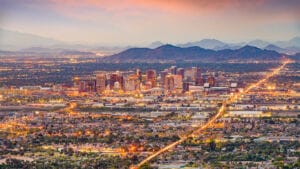Tucson’s economy will continue to expand this year and accelerate modestly in 2018, with growth coming at a pace similar to the nation, but slower than the state of Arizona. That was a key message during the University of Arizona Eller College of Management 2017 Breakfast with the Economists event at the Westin La Paloma Resort in Tucson.
More than 400 people attended the event to hear presenters George W. Hammond, Ph.D., director and research professor at UA Eller’s Economic and Business Research Center, and Federal Reserve economist Gary Wagner, Ph.D., discuss local job growth, new home construction, population growth, trade and export activity, interest rates and government spending, the impact of a stronger dollar compared to the Mexican peso, and first quarter GDP results.
While Tucson’s job growth was expected to pick up steam in 2017, it has softened considerably so far this year, with the metropolitan area adding just 1,700 jobs over the year in the first quarter. That translated into 0.5 percent growth.
“The forecast calls for the Tucson economy to continue to expand in 2017 and to accelerate modestly in 2018,” Hammond said. “Tucson is forecast to add 5,400 jobs in 2017 and 7,200 jobs in 2018. The aerospace sector is expected to contribute to job gains during the forecast, adding high-paying jobs to the local economy. This will contribute to faster income growth and higher incomes for local residents.”
To understand current economic conditions, Hammond gave a brief overview of how Tucson’s economy improved in 2016.
“Tucson’s job and population growth gained momentum last year, accelerating more rapidly than the more modest pace of 2015. Indeed, Tucson added 4,700 jobs over the year in 2016, which translated into a 1.3 percent growth rate. That was far faster than the 0.8 percent rate posted in 2015, and it was our fastest pace since 2012. In addition, Tucson added 3,700 residents last year, for 0.4 percent growth,” Hammond said.
Overall, Tucson’s job growth last year was driven primarily by health services, leisure and hospitality and manufacturing.
“The job growth in manufacturing, spurred by aerospace hiring, was particularly encouraging because wages in that sector tend to be much higher than average. In 2015, manufacturing wages, excluding fringe benefits, averaged $81,576 per worker, compared to the all-industry average of $43,620,” Hammond said.
Tucson lost jobs last year in natural resources and mining, as well as trade, transportation and utilities. Weak commodity prices continued to weigh on copper production in Tucson, resulting in job losses in mining. Construction jobs rose by 300 last year, reflecting in part stronger residential building. Most other sectors posted small employment increases or rough stability.
While local job growth accelerated last year, it remained well below the state and national pace. Arizona increased jobs at a 2.6 percent pace last year, while the national rate hit 1.7 percent.
Looking ahead, Hammond shared several key predictions:
· Continued job growth is expected to translate into additional population gains, with the metropolitan area forecast to add 8,200 residents in 2017 and 9,000 residents in 2018.
· Population gains are forecast to boost residential building in Tucson, as housing permits rise from 2,466 in 2016, according to Census Bureau estimates, to 3,648 in 2017 and then to 3,911 in 2018.
· Tightening labor markets, coupled with a higher minimum wage, drive up wage gains during the forecast. That translates into stronger personal income growth, which is forecast to rise from 3.0 percent in 2016 to 4.1 percent in 2017, and then to 5.0 percent in 2018.
· Accelerating income growth boosts retail sales during the 2017-2018 period, although gains will be slow in part because the U.S. dollar is expected to remain strong against the Mexican peso. That puts downward pressure on Mexican visitor spending.
“Overall, the Tucson economy continues to grow and improve. Last year, the metropolitan area generated the fastest job growth we’ve seen since 2012 and there’s a good chance that the economy will continue to expand this year and next,” Hammond said.
Wagner’s presentation focused on the GDP and the near-term outlook, national employment and labor market conditions, and inflation and monetary policy.
“Despite the relatively weak reading of GDP growth in the first quarter of 2017, the latest forecasts from the Survey of Professional Forecasters point to continued growth at roughly 2.5 percent over the next five quarters,” Wagner said.
Calling the weak growth “transitory,” Wagner pointed to why there is reason to remain optimistic.
“Household spending, which economists call personal consumption expenditures, was below average in January and February before rebounding nicely in March,” he said. “Part of this may be due to the fact that personal income tax filings, and therefore returns, started out the year on a slower than average pace. This may very well shift some consumer spending that would have taken place early in the year back a couple of months. In addition, there is still evidence of residual seasonality in the first quarter GDP data.”
Wagner’s presentation included two other major takeaways:
· Broadly speaking, labor market conditions are better than pre-Great Recession conditions. However, wage growth has been lagging some and weaker than normal productivity may be the culprit.
· The latest guidance from the Federal Open Market Committee (FOMC) points to two additional rate hikes this year. A majority of federal funds futures participants expect only one additional hike.
For more information or to view Dr. Hammond’s slide presentation, visit Eller’s Economic and Business Research website, ebr.eller.arizona.edu.




